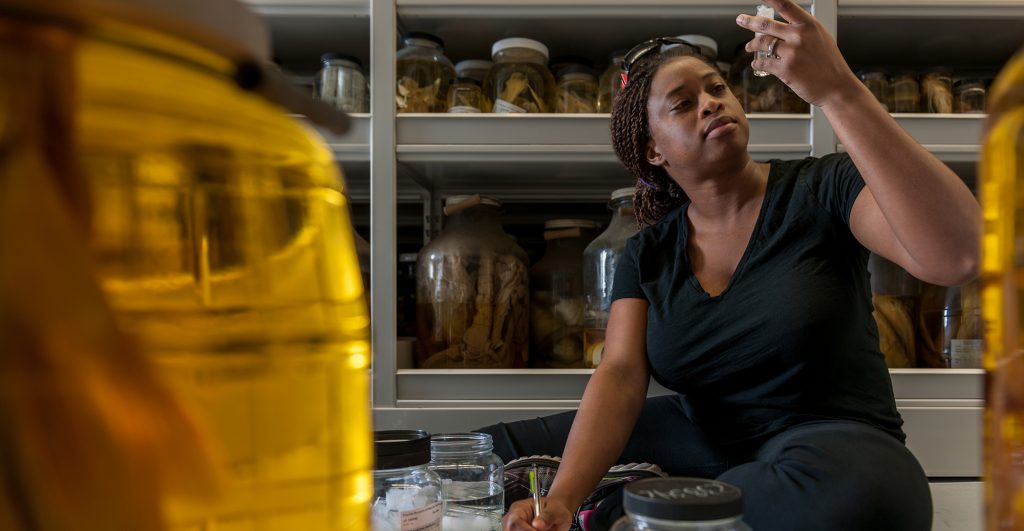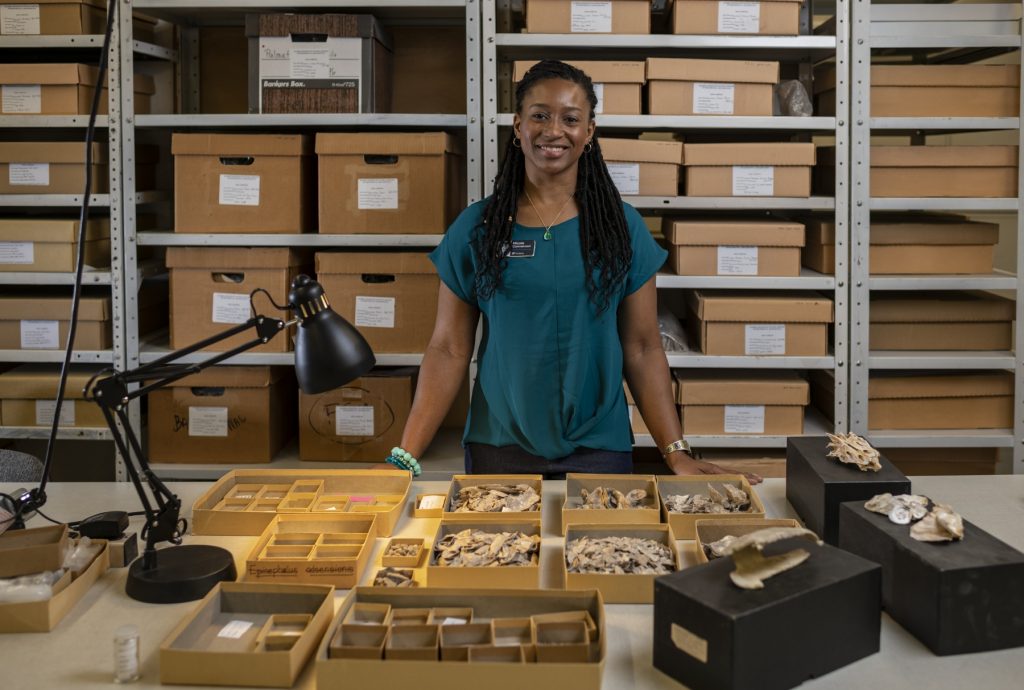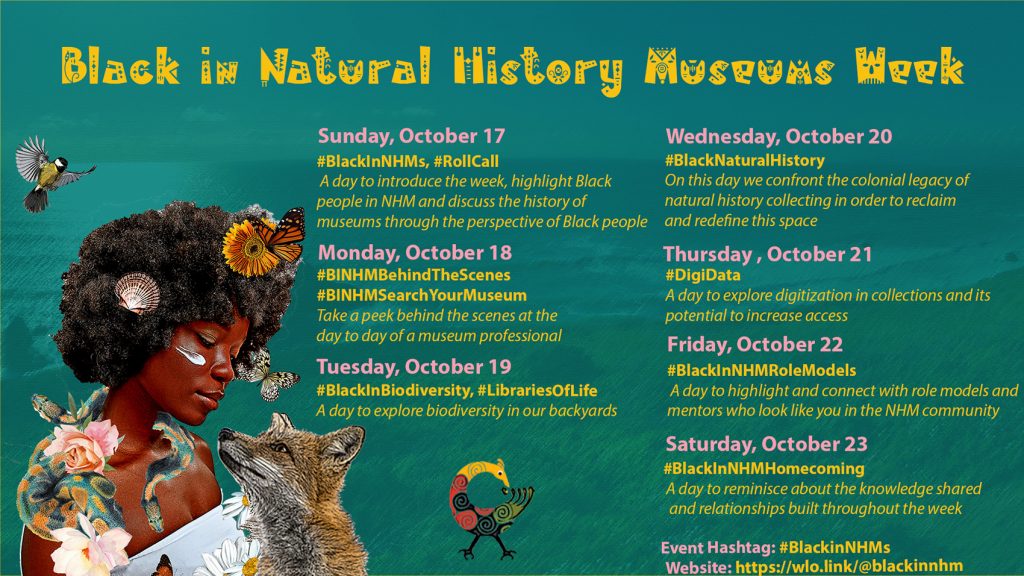The inaugural Black in Natural History Museums Week, Oct. 17-23, is an online social media festival that acknowledges, unites and celebrates Black people who work in natural history museums.
Inspired by the “Black in X” social media campaigns, the week begins with a virtual roll call: a chance for Black museum professionals – everyone from scientists and students to security guards and exhibit designers – to introduce themselves. Each weekday has its own theme and special events. These include a close look at how museums function as libraries of life on Earth; a challenge to find, identify and document local biodiversity; a virtual panel on the colonial legacy of natural history museums; an examination of how technology improves access to museum collections; and tips for finding role models.
“To me, Black in Natural History Museums is about building our own space so that we can thrive and not just survive,” said founder Adania Flemming, a doctoral student in the University of Florida’s department of biology and an iDigBio research assistant. “We’re trying to create a community and find ways we can work together and engage people.”

For Flemming, a fish expert and museum lover, the impetus for the campaign grew out of a question that has nagged at her since she arrived at the Florida Museum of Natural History in 2012: Why are there so few Black people in museums? Nearly absent from the building where she conducted her research, Black people also did not appear at scientific conferences or in the literature she analyzed as part of her biological education research.
“I kept asking, ‘Why are people like me not here?’” Flemming said. “People would say, ‘Oh, it’s because they’re not interested.’ I thought, that’s not why. There’s something wrong with access.”
Flemming issued a callout to museum peers on Twitter in February, propelled by the U.S.’ racial reckoning of 2020 and the lack of a network for Black natural history museum professionals. She felt compelled to find community but also worried no one would respond. Gradually, voices chimed in, and with the help of additional scouting via email, Flemming gathered and mobilized an online group of more than 20 Black colleagues. The team is preparing to launch its social media initiative on Twitter and Facebook next week, with posts marked as #BlackinNHMs.
For Nicole Cannarozzi, the week offers a rare opportunity to convene with other Black natural history museum professionals from all over the world. While the number of Black archaeologists is slowly growing, the field generally lacks diversity, said Cannarozzi, Florida Museum collections manager of environmental archaeology.
“We need to work on evaluating these spaces and determine how they can be more inclusive,” she said.

Flemming, Cannarozzi and their fellow organizers intend for the week to be liberating, inspiring, enlightening and “just joyous” for Black people who work in natural history museums. Allies are also welcome to listen and learn.
“We made the decision to create content that is about highlighting Black experiences, Black perspectives and Black knowledge for Black people,” said Alnycea Blackwell, project assistant at iDigBio. “If other people want to come and enjoy it, that’s awesome, too.”
The team also aims for the endeavor’s impact to last well beyond the week and created a 501(c)(3) nonprofit organization to continue building community, offer mentorship resources and provide research funding to increase the accessibility of natural history museum careers for Black people.
“This is really how you create action and make this a sustainable, supported effort,” Cannarozzi said. “Establishing something like this is the only way to keep it at the forefront.”

Cannarozzi’s career in archaeology began when she was washing fragments of pottery as an undergraduate student. In one bucket, she uncovered a manatee ear bone, which would lead her deeper into the Florida Museum’s collections, eventually learning from then-manager Irv Quitmyer how to identify animals from their remains.
“I fell in love with the work,” she said. “I started to think about what I could do to improve these collections because we’re working with people’s cultural heritage. I’m also here to affect change for the next generation. As scientists, we’re concerned about what our future is going to look like in terms of the Earth that we live on. We need to apply that same sort of long-term thinking to our social environment and the people who will continue to document this biodiversity. How are we going to diversify that?”
Flemming may have started her museum career examining parasites of fish, but her work rapidly expanded to education and outreach as she sought to “pull people into the space and share it.” In the final year of her master’s degree, she created a course to introduce UF undergraduates to natural history collections. Many of her students were unaware that one of the nation’s top university-based museums was on their college campus.
“Seeing the ‘Aha!’ moments in students’ faces is amazing. There’s so much information living in these specimens, artifacts and objects,” Flemming said. “Different people see things differently. We need different people to be able to tackle scientific questions to help make this world a better place. Really, the week is the start of something bigger.”
Follow the events via #BlackinNHMs or visit the campaign website at https://wlo.link/@blackinnhm.
Sources: Adania Flemming, aflemming@flmnh.ufl.edu;
Nicole Cannarozzi, ncannarozzi@floridamuseum.ufl.edu;
Alnycea Blackwell, ablackwell@floridamuseum.ufl.edu